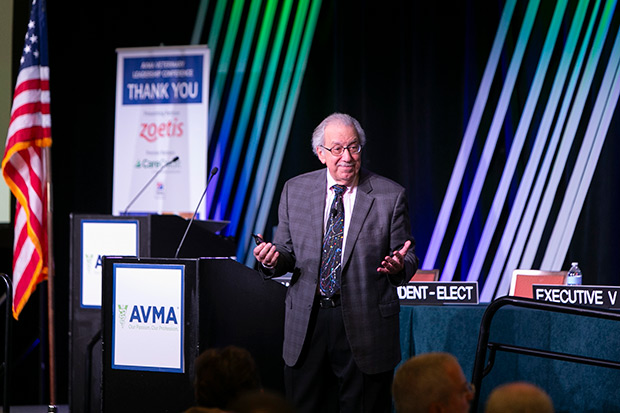Compassion as a catalyst for change
Keynote speaker Richard Boyatzis, PhD, didn’t just walk up to the podium at the AVMA Veterinary Leadership Conference on January 5 in Chicago.
The author and professor started his presentation by clapping and dancing along to “Respect” by Aretha Franklin, and he made sure the audience of more than 700 people was up on their feet, joining him. His goal was to get the audience tapped into their parasympathetic nervous system, which relaxes the body after periods of stress or danger and makes them open to new ideas.
His presentation, “The Science of Inspiring Learning and Change,” focused on how leaders’ levels of emotional intelligence can allow them to create and nurture significant resonant relationships and help their teams be open to new ideas, be more effective, motivate others and innovate.
As a professor at Case Western Reserve University in the Departments of Organizational Behavior, Psychology, and Cognitive Science, as well as the Clark Ford Chair, Boyatzis is an expert on emotional and social intelligence.
Boyatzis co-wrote the bestselling book “Primal Leadership: Learning to Lead with Emotional Intelligence” with Annie McKee and Daniel Goleman, as well as “Helping People Change: Coaching with Compassion for Lifelong Learning and Growth” with Ellen Van Oosten and Melvin Smith.
Addressing the audience, Boyatzis acknowledged that compassion and empathy are inherent in veterinary medicine. “Those of us in this room repeatedly have to call upon our own emotional self-control,” Boyatzis said.
Coaching a desire to change
Boyatzis developed the Intentional Change Theory (ICT), a psychological model that focuses on facilitating sustainable, desired change in individuals and organizations. He found that this type of change happens through discontinuous breaks.
It uses the concepts of an ideal self—who someone wants to be—and a real self—how other people experience that person. From there, someone can create a learning agenda by building on strengths while reducing a gap or two. Next, they begin practicing new thoughts, feelings, and behavior while getting support from others.
He explained that sustained positive change happens when we come to new ideas with openness, not judgement. It also requires diversity of thought and perspective. However, that’s only part of the equation, Boyatzis said. Without effective listening, a leader can’t engage others.
“We still have a tendency, especially when people are in leadership or management positions, to start to devolve into thinking of people as human resources. They aren’t,” he said.
Boyatzis described several of his fMRI studies comparing compassionate and critical coaching methods, and several hormonal studies. Coaching with compassion encourages positive emotional attractors (PEA) such as hope and optimism that arouse the parasympathetic nervous system, versus coaching for compliance, which encourages negative emotional attractors such as fear, stress, and anxiety (NEA) that arouse the sympathetic nervous system.
Sustained desire to change starts in the PEA by using a neural network called the Empathetic Network, focusing on possibilities, dreams, optimism, and hope.
The NEA is the opposite, driving people to do things that are analytic, like financial analysis, and seeking things they need for security, such as holding down a job. Leaders should avoid focusing on employee weaknesses and problems, which give way to pessimism, fear, and defensiveness, which neurologically closes off paths to innovation.
“Giving people feedback is not a useful way to motivate them to change,” Boyatzis said.
It’s the difference between someone being excited about trying something new or defensive over what they deem a threat.
“People are not going to be open to thinking of new ideas or seeing them unless you activate these parts of your interactions that are more PEA,” Boyatzis said. That’s the key to motivating people to innovate.
Surviving and thriving
Humans need to bounce back and forth between these two psychophysiological states if they are to help create balance in life, Boyatzis said. Emotions are contagious, and people are wired to pick up subtle cues and direct brain to brain stimulation from one another.
That means maintaining a ratio between the sympathetic nervous system, which is designed to protect against threats, and the parasympathetic state of “renewal,” which controls being open to new ideasand innovating. In a state of renewal, he explained, “You handle the most complex concepts, you’re the most creative, and you’re the most open to new ideas.”
So how does a person dose themselves every day with a sufficient number of moments of renewal?
“If we don’t intersperse our typical day with these moments of renewal, we start to lose the music of life,” Boyatzis said.
When a person feels renewed and excited, they open their mind and start to innovate and inspire other people, he explained.
“That’s when you start to find–in your families, in your communities, and at your work–people coming together and doing things you never thought were possible.”
A version of this story appears in the March 2024 print issue of JAVMA
Richard Boyatzis, PhD, gives the keynote presentation “The Science of Inspiring Learning and Change” on January 5 at the AVMA Veterinary Leadership Conference in Chicago. (Video by Matt Zingale)

